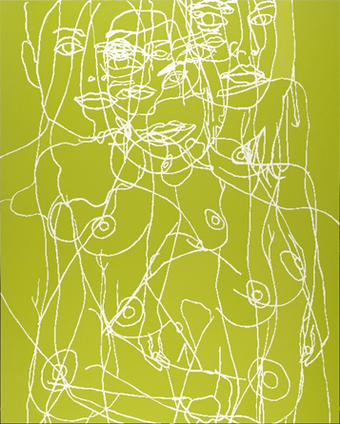
Fig.1
Gary Hume
Water Painting 1999
Household paint on aluminium panel
Support: 3050 × 2440 × 21 mm
Tate
© Gary Hume
In 2012, when about to lightly dust the smooth paint surface of Gary Hume’s Water Painting 1999 (fig.1) in preparation for its loan to the Arts Council exhibition Gary Hume: Flashback, conservator Helen Brett noticed an overall hazy white covering on it that was easily disturbed by touch, leaving shiny marks. Hume uses alkyd household gloss paint, and on close viewing of Water Painting, this widespread surface alteration compromised the bright colour and surface gloss to a surprising degree considering that the painting was only thirteen years old. Cleaning the surface of a contemporary painting is rarely straightforward, and consultation with artists is often essential, not only to seek and record information about their practice and intention for their artwork’s appearance, but also to gather their opinions about its conservation and ageing.1 The desire to restore, as far as possible, the surface of Water Painting for future display was therefore the initial spark of a larger project that culminated in 2015 with the conservation treatment involving the artist, painting conservators and conservation scientists. Our aim in this project was to investigate why Hume’s paintings develop this surface bloom – more accurately termed ‘efflorescence’2 – and to develop a practical conservation treatment. During interviews with Hume we explored his attitude to ageing in his paintings in the context of our collective approach to ageing and change in contemporary paintings in general. Focusing on the efflorescence on his gloss paint surfaces, our aim was to investigate whether we could, or even should, remove it.

Fig.2
Gary Hume
Incubus 1991
Alkyd paint on Formica
Displayed: 2389 × 3846 mm
Tate
© Gary Hume
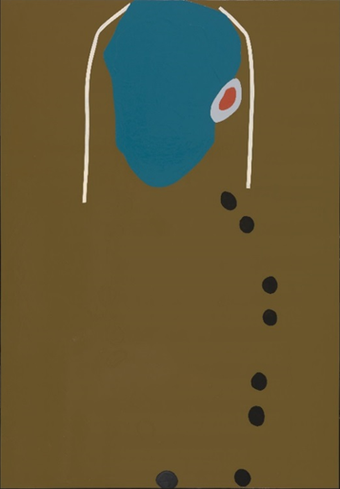
Fig.3
Gary Hume
The Generals 2004
Alkyd gloss paint on aluminium panel
Support: 1790 × 1220 mm
Tate
© Gary Hume
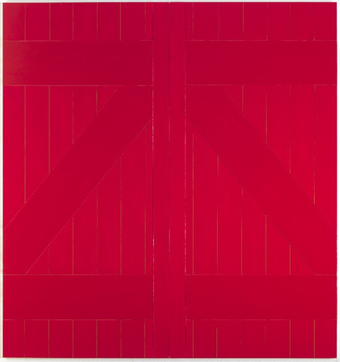
Fig.4
Gary Hume
Red Barn Door 2008
Enamel paint on two aluminium panels
Support, each: 2823 × 1326 mm
Tate
© Gary Hume
Hume’s reasons for using alkyd gloss house paint and his techniques for applying it have been well documented in past interviews, the most comprehensive being with art critic David Barrett in 2004.3 However, our technical analysis of Water Painting and three more of Hume’s works in the Tate collection, which span the first two decades of his career – Incubus 1991, The Generals 2004 and Red Barn Door 2008 (figs.2–4) – gives a new perspective by showing how his experimentation and shifts in technique, sometimes necessitated by the physical constraints of his materials, led to a subtle evolution in his painting surfaces. Investigating the material properties of Hume’s paintings also reveals why alkyd house paints behave differently to traditional artists’ paints, why the phenomenon of efflorescence occurs, and how subtle surface changes might compromise Hume’s intentions.
This article will give a brief introduction to Hume’s career and practice, describing his working methods and artistic aims, with reference to our technical examinations of these four paintings as well as written sources and our discussions with the artist. The phenomenon of fatty acid efflorescence will be discussed using chemical analysis and technical examination of Water Painting, to explain how this painting had become so heavily affected. Finally, we will describe and evaluate the conservation treatment carried out to remove the efflorescence, including a consideration of the ethical questions this posed and how these were resolved.
We interviewed Hume in front of his paintings at Tate Store in London in April 2015. His obvious interest and delight in practical and material matters surrounding his work made this a rewarding experience, and very much a two-way street as we learned from each other. He offered his memories of striving to achieve surface effects and we offered our knowledge of the chemistry of his paints, and we discussed approaches to maintaining their glossy surfaces. Hume responded with honesty and pragmatism when discussing changes his paintings might undergo as they age, and became closely involved in the conservation of Water Painting as it progressed.
Hume’s picture making
Hume describes himself as a ‘picture maker’, not a painter, saying ‘I actually avoided being a painter because there’s too much pressure. I’m a picture maker. I’m picturing things, I’m not really painting them.’4 While an art student at Goldsmiths’ College, London in the late 1980s he began to reject traditional artists’ materials and started his well-known Doors series of paintings using household gloss paint. Between 1988 and 1993 Hume made over fifty pictures for this series that represented large institutional swing doors; Incubus is one such work. He recalls: ‘I went to St Bartholomew’s Hospital [in London] with a tape measure and a piece of paper, measured numerous doors and made schematic copies of them. I used house paint in an institutional colour, magnolia, which is a colour of no choice … it was about democratic use of the symbol of the door.’5 In these representations of doors, Hume’s choice of household gloss paint fitted the trend for appropriating everyday objects into painting and sculpture that had prevailed among his contemporaries at Goldsmiths. The graduation show for Hume’s cohort at Goldsmiths in 1988 was met with critical acclaim, as was the ground-breaking exhibition Freeze that the artists staged themselves in London’s Docklands that same year. These shows helped establish Hume as one of the key figures in this hugely successful group of artists, who have come to be known collectively as the Young British Artists (YBAs). Hume went on to paint more vibrantly coloured doors with varied compositions and titles that conveyed wider associations, of which Incubus is an example.6 With the Doors series, Hume established his signature technique of picture making, and has maintained it ever since, with his range of subjects broadening to include people, flowers and everyday objects. His pictures are characterised by flat planes of gloss house paint on rectangular aluminium sheets. Intense colour fields are joined by low ridges, creating boundaries between colours, and the careful layering of paint is often used to render subtle embossed relief, drawing attention to the physicality of the paintings. As will be shown, this effect was not easy to achieve, and each stage of Hume’s practice evolved over the years; a technical evolution that is traceable on his paint surfaces.
Panels and preparations
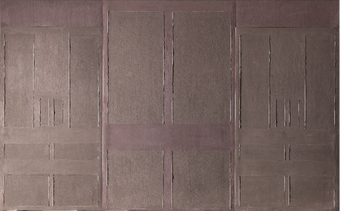
Fig.5
Gary Hume
Incubus photographed in raking light, highlighting the texture of the surface, particularly the ridges created with paint to emulate the panels of a door
Photo © Tate

Fig.6
Gary Hume
Incubus, detail in semi-raking light, showing the subtle differences in surface sheen between adjacent paint passages
Photo © Tate
Hume’s choice of painting support changed during his career, driven by his interest in gloss and surface. His Doors presented a series of technical challenges to be solved through experimentation which led him from his first, most traditional choice of support – the upright canvas – to his most recent: the flat aluminium panel, positioned horizontally as he works on it. In looking for a completely smooth support, Hume’s chief problem with canvas was its texture.7 The use of MDF panels,8 as for his Dolphin Painting I 1990–1 (Saatchi Collection, London), provided the smooth, door-like surface he sought, but posed practical handling problems due to the panels’ weight and their surprisingly fragile edges. Hume noticed how the MDF panels became distorted in response to changes in humidity, most noticeably when they were moved from the studio space to air-conditioned galleries while he was working in New York in the summer of 1991 for an exhibition at Matthew Marks Gallery. Incubus was painted at this time, and in response to these problems he tried a new support of aluminium honeycomb faced with Formica sheets, using five of these panels to make up the overall structure.9 Paint would not stick to the smooth surface of the Formica, so the rougher reverse of the sheets was turned to face outwards, providing a textured surface for the paint. However, the painted surface replicated some of this roughness, and even after sanding down it could not offer the smooth finish that Hume wished for (figs.5 and 6). In addition, although the aluminium honeycomb and Formica combination provided an inert, strong and stable support, it proved too heavy. As Hume observed: ‘It was supposedly based on helicopter technology, but – bloody hell! – you would need a big engine to lift a helicopter made out of that stuff.’10
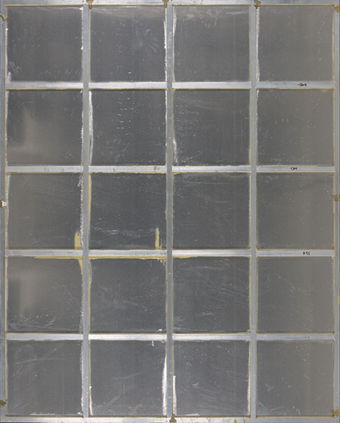
Fig.7
Gary Hume
Water Painting, reverse, showing the aluminium sheets and supporting structure
Photo © Tate
The use of aluminium sheets as a support was proposed by the designer and fabricator Mike Smith in response to Hume’s need for a material that would mimic a traditional canvas and stretcher, but would also be smooth, inert and light, without the risk of scuffing corners on the studio floor.11 Water Painting is a good example of these early aluminium panel paintings. The support is made up of two aluminium sheets, each two millimetres thick, abutted and joined with epoxy glue and supported by an aluminium box framework glued to the reverse with the same adhesive (fig.7).
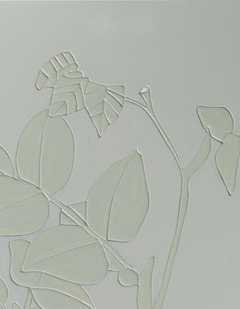
Fig.8
Gary Hume
Double Exposure 2015, detail of the top right hand corner of the second panel in the diptych
Gloss paint on aluminium panel
Each panel: 1220 x 780 x 21 mm
© Gary Hume
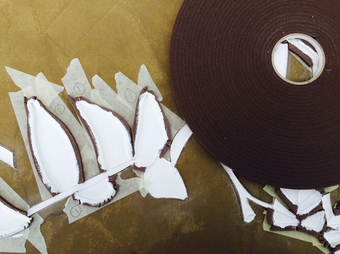
Fig.9
Gary Hume
Double Exposure during making, showing the brown colour of the primer that was applied with a roller to the surface of the aluminium panel, and self-adhesive foam draught excluder and masking tape used with paint to create boundaries and texture
© Gary Hume
Initially, aluminium was simply a solution to a problem, but its surface quickly became incorporated into some of Hume’s works, as seen in Kate 1996 (White Cube, London), where the face is a blank oval of exposed aluminium. Hume describes the aluminium panel as ‘something absolutely lovely, this big shiny rectangle that you’re just about to ruin, rather than a piece of canvas that already says, “I’m empty, do something to me.” With my first mark the beauty is gone forever.’12 His notion of ruining the surface becomes clear when he describes preparing the aluminium, which he degreases and roughens to allow it to receive the gloss paint.13 For Water Painting, Hume drew the outlines and then painted directly onto the degreased panel, although subsequent panels were first primed with a coloured two-part acid etch primer. This method was used for Hume’s 2015 painting Double Exposure (fig.8), where a brown acid etch primer was applied with a roller to the aluminium surface (fig.9).14
Starting points: Drawing, projecting, planning
Hume derives the subjects of his paintings from existing images found in historic paintings, books and magazines, as well as from photographs he has taken: ‘I’ll come across something that suddenly grabs my attention and then I’ll start tracing that, and drawing from it ... hoping that I’m going to be able to see a painting in there.’15 These found images are transformed and edited during his working process such that the final image often bears little resemblance to its visual source, though titles can provide tantalising clues as to what this source might have been. For example, the ambiguous figure seen in the 2004 painting The Generals (see fig.3) is derived from two places: a historical picture in a book on the American Civil War, and Hume’s experience of hearing a military leader speaking on American radio at a time when the US- and UK-led war in Iraq was dominating the media. Describing his motives for transforming these sources, Hume says ‘I was just thinking that nothing … changes, and I wanted to make him [the General] into an absurd and hideous clown’.16
Hume traces his source images onto sheets of acetate with a permanent marker pen, and then uses an overhead projector to project them onto the wall, finally selecting just a portion to use for his painting and tracing that onto an aluminium panel. He then uses this as a plan to create adjacent planes of colour: rather than using outlines to distinguish these planes, Hume allows them to abut directly on the surface. This avoidance of the pictorial device of the line was developed in Hume’s Door paintings, and is arguably more faithful to the way that objects appear to the eye, rather than being set in rigid outlines.
The outlining of figures in Water Painting was therefore a divergence from Hume’s usual treatment of form, contrasting with his more typical hard edge juxtaposition of colour shapes. The image for Water Painting is derived from a collection of tracings on acetate that Hume had made from photographs of his wife – the artist Georgie Hopton – and his friend Zoe Manzi. He describes a revelatory moment in his discovery of line:
I had the overhead projector, and I was trying to find another painting, and I had put eight sheets on at once, [went away] to have a cigarette or cup of tea, and I looked and … I started moving them about and what was the most incredible thing, it was incredible, was that I’d never looked at the lines! Because previous to this painting, I just saw how things met. Suddenly I had this whole drawer of lines that I’d never looked at … and that led to a whole series of work.17
These works were all called Water Painting and were made for Hume’s exhibition for the British Pavilion at the 48th Venice Biennale in 1999.
Low relief: Junctions and texture
Hume has often created subtle and enigmatic texture effects in his paintings, ranging from smooth forms that are barely discernible on the surface to sharp ridges that act as boundaries between different passages of paint. For Door paintings such as Incubus, Hume’s process of painting is akin to the methodical, step-by-step technique associated with decorating real doors (see fig.5). The sharp ridges in Incubus are suggestive of a door’s inset panels and were built up using a white oil-modified alkyd house paint undercoat, which was also used to prime the panel. Hume applied a temporary boundary or ‘dam’ to the support using multiple layers of masking tape and then, with the support laid horizontally, brushed successive layers of white undercoat up to meet the edges of the dam. Once the paint was dry, the dam was cut and peeled away. This method of creating ridges quickly became part of Hume’s signature technique, and he has described it as follows: ‘I used to think of the areas of colour as tectonic plates … these molten plates that would hit each other and dry. I wanted one of those plates to be higher and I wanted the hit to be more abrupt.’18
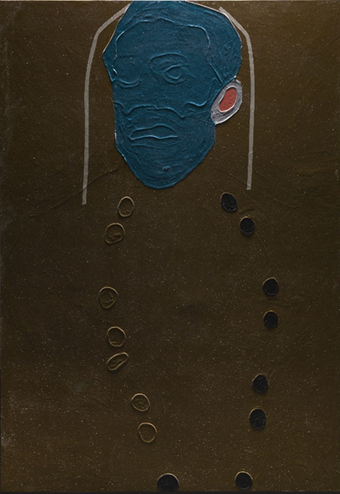
Fig.10
Gary Hume
The Generals photographed in raking light, revealing surface texture
Photo © Tate
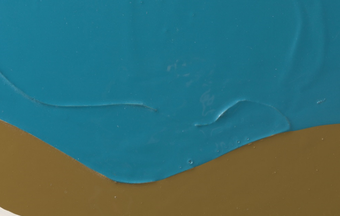
Fig.11
Gary Hume
The Generals, detail of the face, showing soft ridges of paint
Photo © Tate
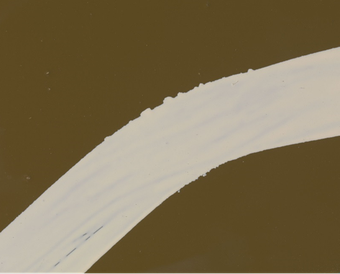
Fig.12
Gary Hume
The Generals, detail of the white lines either side of the head, showing where paint that has bled beneath the masking tape used to create crisp edges
Photo © Tate
The Generals features similar ridges created in the white undercoat (fig.10), separating the blue passage that forms the face from the brown surrounding it (fig.11). By the time this painting was made in 2004, however, the laborious, fiddly process of making dams purely from masking tape had been superseded. Hume had discovered foam draught excluder tape and was using it consistently, though simple masking tape techniques were still used in The Generals, as revealed by the white lines on either side of the head, where the paint has seeped under the edge of masking tape at the curve in the line (fig.12). In Hume’s new technique, a strip of self-adhesive foam draught excluder was stuck over protective pieces of masking tape, instantly creating a deep boundary that could be cut easily with a scalpel to form curves. This process was used for Double Exposure, as seen in fig.9, which shows a roll of draught excluder lying on the surface, next to some leaf shapes which are outlined with foam and filled with white undercoat paint to create the painting’s relief effect (see fig.8).
In The Generals, the features of the bearded face and the buttons of the uniform are described by soft mounds in the paint surface formed from built-up layers of undercoat that were applied freehand with a brush and finally sealed beneath a thin layer of coloured Dulux gloss paint (fig.11).19 This effect is exaggerated when the painting is viewed in raking light, which emphasises the low relief of these shapes, particularly in the buttons and face (fig.10). This distinctive low relief surface texture seen in many of Hume’s paintings led him to describe them as ‘the thinnest sculptures in the world’.20
Handling gloss
Throughout his career, Hume has always favoured household gloss paints. As he has commented:
[O]nly when I started using it did I realise how beautiful gloss paint is: the nature of it is so perfect, it’s very different to oil paint, which can mimic different surfaces. For example, with an oil painting of a vase you’re aware the image is constructed out of paint but feel you know the material of a vase. Whereas with gloss paint you are always aware that the picture is just a thin film of solidified liquid.21
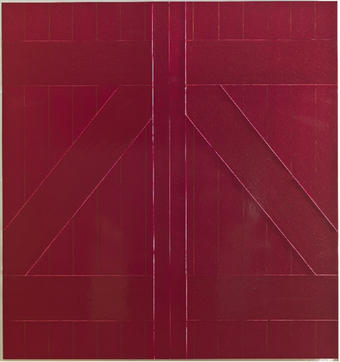
Fig.13
Gary Hume
Red Barn Door photographed in raking light, revealing textural differences, ridges and brush marks
Photo © Tate
In this way, the medium lends itself perfectly to Hume’s interest in form and surface and he admires its connotations of ‘modernity and ordinariness’.22 He has described how gloss adds an extra dimension to his work: ‘[I]ts qualities still intrigue me. It’s viscous and fluid and feels like a pool. It’s highly reflective, which means there are layers of looking. You look at the picture, and you look at the surface, then you look at the reflection in the surface behind you, then you look at yourself.’23 Hume has described how one of his chief pleasures and motives in using gloss house paint is that it ‘carries light’ without creating the illusion of light: ‘There’s no illusion of three-dimensional space in the works, but there is plenty of time: light time, because they change throughout the day. I never paint light, but I wanted to be able to have light in the pictures. Gloss reflects the light that we have – the sun and artificial light – it can hold the light by reflecting it.’24 These comments reveal the importance of a glossy surface to Hume’s artistic aims.
How does household gloss paint achieve these effects so valued by Hume? Oil-modified alkyd resins are the main binder used in all fast-drying gloss household paints. Alkyds are polyester resins, named after the alcohol and acid components that form the polyester matrix. For long oil alkyds such as gloss household paints, 60–80% of their total weight is added oil, which gives them enough ‘body’ for painting and enables the naturally brittle resin to remain flexible once dried.25 Alkyds dry by the same process as pure oil paints (through film formation via chemical bonding of the initially liquid oil and polyester portions, which forms a solid film), but due to the polyester component they have a much faster drying time – a key success factor for the commercial market. Designed as exterior coatings, commercial household paints can have many other components added to them that affect properties such as gloss, self-levelling,26 and resistance to ultraviolet light and weathering. Alkyd paints that dry to a matt (‘eggshell’) or semi-matt (‘satin’) finish are formulated with higher levels of solids, particularly extenders.27 Due to their low viscosity, alkyd household paints are well adapted for brushing and self-levelling and do not tend to hold the marks of the brush.
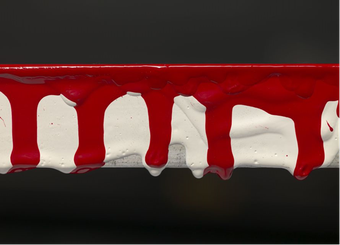
Fig.14
Gary Hume
Red Barn Door, detail of the panel edge, showing drips of the white undercoat used to create texture and drips of the subsequent red layers over the top
Photo © Tate
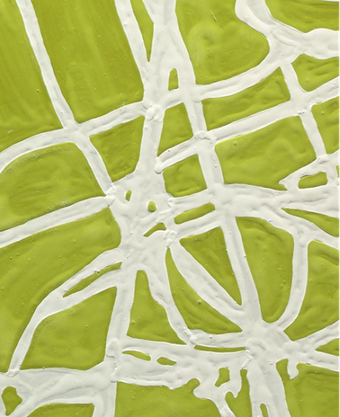
Fig.15
Gary Hume
Water Painting, detail in semi-raking light, showing the soft texture echoing the brush strokes used to apply the paint and the overlapping strokes used for the white lines
Photo © Tate
Over the years Hume has tried different brands of household paint depending on location and availability. The differences he has found have certainly had an impact on the effects seen in his paintings, and favourite brands have emerged. When painting Incubus in New York, Hume quickly discovered that the American market appeared not to have the same appetite for high gloss as the British one did. His choice of paint was therefore restricted to Benjamin Moore paints,28 a brand with a reputation for high quality: they were used by Frank Stella in what is known as his Benjamin Moore series of paintings from the 1960s (see, for example, Hyena Stomp 1962).29 As a result, the surface of Incubus has a softer sheen than that of Hume’s later, highly glossy, reflective paintings (see fig.6). He recalls his disappointment, describing the paint as thin and less glossy than Bromel30 or Dulux paint: ‘[I]t’s not nice. It doesn’t even like being painted.’31 In London he used Bromel paints until the Bromel factory was devastated by a fire in 1996 and production ceased, prompting him to adopt Dulux paints. Since 2002, Hume has divided his time between studios in London and in Accord in upstate New York, and while working in the US he uses a high-quality specialist decorator’s glossy alkyd, Hollandlac from Fine Paints of Europe, a product range made by the Dutch manufacturer Ralston for the US market; see, for instance, the high gloss red paint used for Red Barn Door 2008 (fig.13).32
Working with house paints requires different methods of application to those used for artists’ oils, acrylics or even oil-modified alkyd artists’ paints. Hume lays his panels horizontally, either on the floor or resting on pots of paint, to avoid drips and runs forming as the liquid dries on the surface. Instead, the drips form patterns on the edges (see fig.14, and figs.18 and 19, below).33 To make Water Painting, Hume projected the design, derived from drawings on overlapping acetate sheets, onto the upright aluminium panel and traced it on using pencil. He then lay across the aluminium surface to paint it in stages, starting with the greens and leaving a reserve for the white lines. The paint was applied with a brush, free hand, without masking off. The self-levelling behaviour of alkyd house paint means that the green paint now shows only subtle rippled mounds, describing the strokes of the loaded brush as it followed the pencil lines, creating a striking effect when the painting is seen in raking light (fig.15). Hume recalls the difficulty in painting the intricate white lines, and the danger of the paint becoming ‘claggy’ if it were allowed to dry too much before different lines merged.34 Although Water Painting required a relatively simple build-up process, its sheer size – 3 metres high and almost 2.5 metres wide – must have made its creation a formidable task.
Indeed, the labour involved in painting these large works on aluminium is such that Hume now concentrates on his large aluminium paintings while in London, where he has an assistant for two days per week, rather than when he works on his own in the US, since the panels there are made with a thicker aluminium sheeting and are ‘unbearable to lift’ alone.35 He now works mostly on canvas and paper when in the US.36
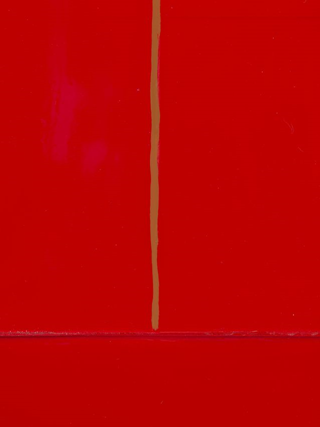
Fig.16
Gary Hume
Red Barn Door, detail of olive-green lines and ridges
Photo © Tate
In London, Hume’s assistant Zoe Griffiths carries out the more laborious tasks, applying the tape and foam to Hume’s drawn lines and filling in areas of undercoat. Hume explains that ‘She’s very, very good at what she does and sometimes I don’t want that … when I want there to be a bit more chaos, or something a bit wrong, then I have to do that bit.’37 Although his choice of materials and creative process lend an air of industrial fabrication to the paintings, evidence of the artist’s hand is important to Hume: ‘They’re not machine made. They’re entirely human.’38 For instance, the thin, olive-green lines delineating the planks of wood on Red Barn Door were made without masking tape, laid in before the red was painted up to them by hand (fig.16). ‘I’m not really fussy about it,’ claims Hume. ‘I like wobbles ... if I need a straight line, I’ll draw it … And all my straight lines go at an angle, because I can’t draw a straight line. But I don’t mind … I want them to be handmade.’39 Even when using masking to create a sharp line, Hume has not corrected imperfections caused by the paint bleeding under the tape – as we have seen, for example, in the cream-coloured bands in The Generals (fig.12).
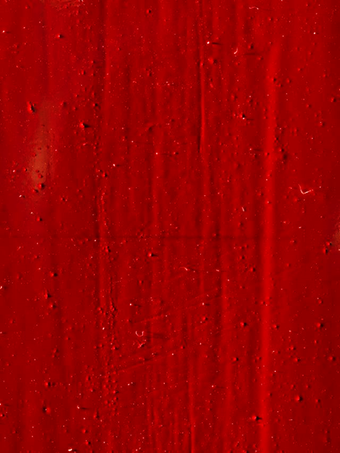
Fig.17
Gary Hume
Red Barn Door, detail in semi-raking light, showing debris trapped in the paint, scratches and other artefacts of the surface preparation
Photo © Tate
In keeping with this approach, Hume has talked about the practicalities of achieving the smooth gloss surface he wants. ‘When I started making the door paintings, I spent countless hours trying to exclude nature. I was living in the natural world but trying to make something like a machine, in a completely controlled environment. At some point I had to stop fighting nature and allow it to take part.’40 A close examination of the surface of Red Barn Door shows the realities of painting during the summer in his converted barn in Accord, where dust and debris are easily trapped in the gloss paint (fig.17). Hume has explained: ‘I’m in a chicken coop in the middle of summer. I’m dripping with sweat on it while I’m painting.’41
Colours and non-colours
The ready-mixed colour range of household paints fits with Hume’s artistic intention since, as the artist has observed, ‘they’re not echoing anything, whereas artists’ colours are created to echo. You know, the earth colours, the earth, the flesh colours… everything is there to echo, whereas hardware colours are there to decorate, obliterate and cover … we’re not echoing.’42 He initially restricted himself to the familiar ‘non-colours’ of real institutional doors: ‘mushroom’, ‘mint green’, ‘brown’ and ‘magnolia’.43 Incubus is a good example, with its insipid pink hue. Hume has stated of these colours: ‘They were true to themselves. If you painted the door at home at that period, everything was gloss. Now it’s just a luscious material to make an image.’44 He was appreciative of the vast choice of colours available in his chosen medium and the opportunities that this afforded: ‘The range is just so much greater for shopping so I can go to a hardware store and there’s at least a thousand colours that I can shop for. And I can go to my art store, and the section I can shop from is about a yard by a yard.’45

Fig.18
Water Painting, detail of panel edge, showing the overlaying of green passages with subtly different green hues
Photo © Tate
Hume paints directly from the tin but also adjusts the tones by mixing paints.46 For Water Painting (see fig.1) Hume used subtly different shades of green.47 He recalls that he may have chosen two different types of alkyd house paint: an eggshell or satin paint for the lighter, more yellow tone, and a gloss for the darker green.48 The lighter green was used for Georgie’s figure, which he positioned behind other superimposed figures, and this shade is seen, for example, within the outline of her shoulder at the left edge of the composition. Most of the other areas are filled in with the darker green. In some areas Hume applied more than one layer to change the colour, as the overlapping drips along the side of the panel make clear (fig.18). The opacity and covering power of the paint allowed the new layer to completely obliterate the colour of the one underneath.

Fig.19
The Generals, detail of the panel edge, showing the original yellow colour and the brown that Hume painted over it
Photo © Tate
In 2004 Hume described his studio as containing ‘hundreds and hundreds of tall paper cups that I mix the colours in’.49 In his works from around this time his colour choices are often highly expressive and evocative. Discussing his 2004 painting The Generals, Hume recalls that at that time:
When I was in America there were yellow ribbons everywhere … this was because of the Gulf War [in Iraq], everywhere you’d go there was a yellow ribbon … So I’m using yellow, I’m not using yellow like van Gogh used yellow, I’m using yellow as the emblem for ‘our boys’ … At one point this [painting] would have had the yellow ribbon colour in it. And clearly that didn’t work out and then I wanted the colour like the shit in a child’s nappy … I needed something very earthy [fig.19].50
For Red Barn Door (see fig.4) Hume chose a bold, vibrant red paint, steering away from the traditional colour used for this architectural feature, which he describes as ‘a softer and much more calm and lovely red. I wanted to turn it up … it’s just so exciting when you make a red painting.’51 The painting was made in the US, and Hume saw this specialist decorator’s gloss paint as his only choice there, since ‘virtually everything you get in a hardware store is acrylic now’.52
Hitting a certain age
Hume’s earliest works are now almost forty years old and we might expect them to start showing evidence of ageing. Yet house paints are designed to be durable in conditions far removed from those found in environmentally controlled art collections. The manufacturers’ concerns are how resistant a paint is to ultraviolet light, its behaviour when exposed to extremes of temperature and humidity, and the length of time that it will perform as a protective coating before needing to be replaced. Given this, Hume’s paintings should remain extremely stable in a museum environment. However, there are important differences in expectations between artist’s paints and household paint – the former are formulated with permanence and legacy in mind, but the latter are generally only expected to perform well for the lifetime of a colour scheme within the home. No one would expect the gloss paint used to paint a door to be unchanged in a hundred years.

Fig.20
Gary Hume
Water Painting photographed in raking light, showing fatty acid efflorescence over the entire surface and concentrated in passages at the top right
Photo © Tate
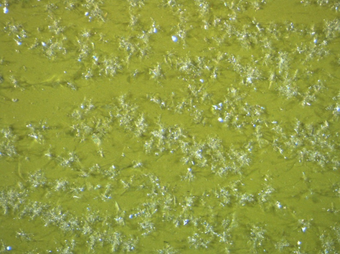
Fig.21
Gary Hume
Water Painting, detail of the large fatty acid crystals under a microscope
Photo © Tate
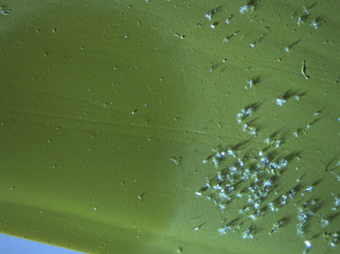
Fig.22
Gary Hume
Water Painting, detail under a microscope, showing the overall efflorescence layer with some larger crystals, contrasted with a cleaned area
Photo © Tate
White surface deposits, often described as ‘bloom’ but more accurately known as fatty acid efflorescence, are often noticed on the surface of the gloss paint of Hume’s works, and originate from within the paint, albeit influenced by external (and internal) conditions. This efflorescence not only reduces the colour and gloss effect intended but can also lead to increased and uneven dirt retention across the surface. In the thirteen years between its creation and our examination of the painting, pronounced efflorescence of this kind had formed on Water Painting (fig.20). A soft matt haze covered the entire surface. At high magnification the haze was revealed as a covering of tiny transparent crystals on the paint surface that were typical of fatty acids; these scattered light, causing the strongly coloured paint to appear cloudy and unsaturated (fig.21). In specific passages such as at the top right corner, where Hume had painted over the lighter green eggshell paint with a darker green gloss paint, much larger crystals had formed a thick glittering carpet superimposed on the more general haze (fig.22). This more pronounced effect was confined to the areas where eggshell paint was used, suggesting that its appearance had been promoted by the nature and structure of that paint formulation. The larger crystals could be brushed from the surface easily, leaving the paint surface beneath unaffected. These crystals had a waxy feel and could be rolled together into a soft white ball. The overall layer of smaller crystals appeared more bound to the surface, requiring persistent friction with a dry swab to clear. Analysis of a sample confirmed that the crystals were fatty acids, with a close match to palmitic acid, a saturated fatty acid that remains mobile (not chemically bonded and locked into place) within a dried oil-containing film.53
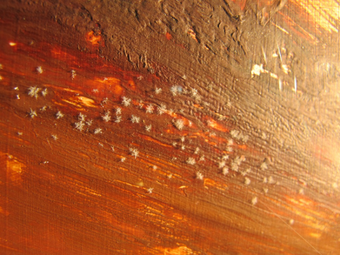
Fig.23
Sidney Nolan
Camel and Figure 1966, detail showing large crystals of fatty acid efflorescence
Photo © Tate
Fatty acid efflorescence is a well-known surface phenomenon and has been reported on the oil, alkyd and egg tempera paint films of artworks made in a diverse range of styles and at various points in history.54 Examples from Tate’s collection include Still Life by Diego Rivera, painted in oil on panel in 1916, Bronze Ballet by Edward Wadsworth, painted in egg tempera on linen laid onto panel in 1940, and Camel and Figure by Sidney Nolan, painted in alkyd on hardboard in 1966. The latter had efflorescence that was visually very similar to the large sparkling crystal clumps seen on Water Painting and was also found to be nearly pure palmitic acid (fig.23).55 In this case the crystals were easily removed by dusting. However, this phenomenon will normally recur (hopefully at a slower rate) and the artworks affected will require maintenance to keep the efflorescence from building up.
Understanding efflorescence
The earliest scientific literature on efflorescence in paintings (and ‘ghost’ images found on the inside of picture frame glass) dates from the 1950s, and by 1988 conservator Scott R. Williams had defined the phenomenon as being due to the exudation of fatty acids from within the paint itself.56 In 1998 scientists Michael Schilling, David Carson and Herant Khanjian further refined ideas about the evaporation and re-deposition of fatty acids onto glass.57 Other articles from the 1990s describing paint surface efflorescence mainly concern oil paint media, for example paintings by Frank Stella, Serge Poliakoff and W.H. Charlton.58 In their important article on efflorescence from 1998, Eugena Ordonez and John Twilley describe efflorescence on alkyd paint used by Claes Oldenburg in sculptures from the 1960s.59 For Hume, the most relevant source is Richard Mulholland’s PhD thesis from 2010 in which he describes and analyses efflorescence on alkyd media used in drawings by David Smith from the 1950s and 1960s.60 Mulholland provides a useful overview of the previous literature on efflorescence and offers a hypothesis as to how and why this efflorescence had formed on Smith’s works. He argues that it was due to storage of the drawings in an environment with large fluctuations in humidity and in tight stacks that allowed no air exchange, effectively enclosing the paint and preventing the evaporation of any free palmitic acid.
Drawing on this body of literature and our own findings, we can summarise what is happening to Hume’s surfaces in this respect. Fatty acids are found in oils, alkyds, egg, fats and both synthetic and natural waxes, and are therefore present in a range of traditional and modern artists’ paints, either as components of the media or as additives. For example, fatty acids can be added to stabilise paints, or as extenders to the medium to lower costs, or to help disperse pigment particles throughout the medium, breaking up conglomerates.61 In oils, alkyds, some waxes and egg, most fatty acids are present in the form of triacylglycerides, which cross-link during the drying process to result in a hardened film.62 However, the small proportion of unreacted, saturated, ‘free’ fatty acids – those that are not locked into the hardened film – can, in time, migrate through the paint film, emerging onto the surface.63 In addition, free fatty acids can be formed through the breakdown of the oil (lipidic) fraction of a paint. Once at the surface the most volatile fatty acids simply evaporate, but those with higher molecular mass and higher melting points, such as palmitic and stearic acids, tend to crystallise. The complex mechanisms behind the production and movement of fatty acid efflorescence, and the effect of external factors such as relative humidity, temperature, painting layer structure and pigment interactions, are the subject of ongoing studies.64
Compared to the artworks described in the literature cited above, Water Painting is unusual in that it had developed a significant amount of efflorescence within a short time span and while stored and displayed within a controlled museum environment. Two of the common factors known to promote efflorescence are therefore not particularly relevant here – that the painting has been exposed to high humidity and that the painting has not been framed and glazed or somehow enclosed since painting.65 How, then, can we account for this high level of efflorescence? We know that Hume used Dulux household gloss paints directly from the can, with no alteration apart from mixing with each other, so the efflorescence is not due to any additives chosen by him. Studies have shown a strong correspondence between fatty acid efflorescence in oil paint and the presence of organic pigments, and revealed that efflorescence does not tend to occur over passages containing inorganic (divalent metal ion-based) pigments such as lead white and cobalt blue.66 This is because these metal-based pigments tend to react with free fatty acids to form metal soaps (or metal carboxylates) through a process that effectively keeps these fatty acids within the paint layer and prevents their migration to the surface. As the paint layers in Water Painting contain few inorganic pigments, any free fatty acids are unlikely to be trapped through metal soap formation.67 The absence of a traditional, absorbent support structure may also be significant. A traditional canvas prepared with a ground layer containing lead white or other inorganic pigments can provide a porous structure that can absorb oil from overlying layers and also promote the formation of metal soaps. In contrast, Hume’s aluminium panel is an impermeable layer, offering no absorption potential, which renders the fatty acids more likely to migrate onto the surface.
The efflorescence on Water Painting was increased in areas where Hume recalled that he had used eggshell finish paint, in passages at the top right and mid-left of the composition.68 In these places Hume painted over layers of paint that he had applied earlier, thus increasing the thickness of the paint surface, which in itself would increase the relative fatty acid content. In raking light the painting’s surface shows clearly defined passages of efflorescence at the top right and mid-centre left, where Hume built up layers of different coloured green paint, including eggshell layers (fig.20). Passages without the eggshell layer are less affected by efflorescence and the white paint even less so again. To achieve an eggshell or satin finish, alkyd paints are formulated with a higher proportion of solids to medium than their glossier counterparts, forming what is known as a lean paint. The chalk, gypsum and kaolin identified in samples from the worst-affected paint in Water Painting are typical extender materials of this kind.69 Although leaner paints have lower medium content, and hence a lower potential fatty acid content, the higher solid content imparts a more porous and open structure to the paint film when it dries, reducing sheen but also potentially leaving increased channels for volatile elements to physically leave the paint, resulting in higher amounts of efflorescence.70
Water Painting is made up of two sheets of aluminium that are joined to make a single support, and it is interesting to note that no efflorescence had occurred over the small band of adhesive used to join them together; here it is assumed that the adhesive may retain the fatty acids through chemical attraction and/or have fewer channels to migrate to the surface.71 This thin band remained glossy, acting as a useful visual reference for how the surface might have appeared originally.
Restoring gloss: Conservation issues
Efflorescence on traditional paintings has commonly been viewed as a form of deterioration and has for the most part been removed, with conservators viewing it in the same way as they might consider a deposit of surface dirt. Contemporary art, with its increasing use of widely diverse and sometimes unstable media, frequently presents new complexities regarding ethical approaches to preservation, and the conservation profession has responded by broadening its framework of principles.72 When thinking about how to approach the care and preservation of Water Painting, we faced some interesting ethical considerations, as this efflorescence, though it disfigured the work, was composed of original paint material. Before proceeding with treatment it was essential to consider the artist’s views on change, the notion of patina and our collective evaluation of what is most important in the appearance of Hume’s work.
Of course, we were fortunate to be dealing with a living artist, as any changes to their artwork could be measured against their opinions as well as the collective memory of the work’s original appearance. Hume is still making paintings like Water Painting, and so his judgement of how far its appearance has changed is likely to be accurate. The importance of Hume’s gloss surfaces as an artistic choice prompts a reassessment of what we value and aim to preserve in these artworks. This efflorescence, a natural ageing characteristic of the paint, clearly compromises the intended appearance of the paint surface by reducing its surface gloss and de-saturating its colours.
The efflorescence was unforeseen by Hume, who rejects it and places no value on its identity as an original component of his paint.73 In fact, he maintains his own gloss surfaces, using cotton wool to wipe them. ‘If they look great and look interesting, and the thing that seems like it was crucial to their value, such as glossiness, if that dissipates and they still retain their value as an object, then I’m happy. If that is lost, then I’m unhappy … and somehow or other … try and reinstate that.’74 However, Hume has worried about ‘making little circles’ on the surface when cleaning his own paintings, either from abrading the paint or moving the fatty acid efflorescence around. He has noted on cleaning them himself that the paint ‘doesn’t get as shiny, but the bloom totally goes’.75 Following the examination, consultation and testing outlined above, we decided to remove or reduce the efflorescence.
Conservation treatment
From a practical point of view, treating Water Painting was an intimidating prospect. Removing efflorescence from more traditional paintings can be easier as the paint texture and matt and gloss transitions help to disguise stubborn residues and distract the eye. Smooth and highly glossy planes of flat colour are not a forgiving surface, and every slight mark and residue is obvious. Even observing and documenting the surface is physically difficult, as obliquely reflected light (that which is cast at a low angle across the artwork) is necessary to properly reveal the gloss. Tactics familiar to conservators in such scenarios were utilised, for example making cleaning tests in small, discrete areas bounded by the white lines to minimise their visual impact.
A gloss metre was used to record and monitor the gloss of the surface before and after testing and cleaning.76 The foot of this instrument was covered with silicone parchment to protect the paint as it made contact. Selected low-risk solvents and various dry friction methods were evaluated using the metre and through observations made by eye. Seven low-polarity, purely or mainly aliphatic solvents were tested, chosen to match the expected solubility of the fatty acids. Preliminary tests had revealed that solvents with a higher aromatic content could affect the paint, so these were eliminated from the list of candidates.77 Friction applied via dry cotton wool, latex smoke sponge,78 Groom Stick putty79 and microfibre cloth were all tested. While effective at recording overall levels of gloss, the metre was not able to register marking that was imparted to the surface by cleaning methods even when they were very obvious to the eye, for example smears, wipe marks and transferred texture from cloths and sponges. Its use here was mainly to gather data for monitoring future change.
The metre results showed that dry cotton wool and dry microfibre cloth reinstated the highest gloss, with iso-octane and petroleum solvents applied using cotton wool swabs producing a gloss that was nearly as high. However, the weave of the cloth tended to impart marks and the amount of friction necessary to remove the efflorescence with dry cotton wool was felt to be excessive, causing concern about abrasion of the paint surface. As this treatment is likely to be repeated in the future, it was important to try to avoid the attrition caused by even microscopic abrasions to the glossy paint surface as far as possible. Solvent methods were optimal in this respect as the solvent both dissolved the efflorescence and lubricated the movement of the swab over the surface. All the solvents were successful in dissolving the efflorescence, though in every case it was easy to leave streaks of re-deposited material in tidemarks and trails that followed the movement of the swab, marks that became visible once the solvent had evaporated. Firm wiping with further dry cotton wool swabs was required to absorb these residues. For this reason, a fast solvent evaporation rate became critical for a successful clean, and we chose a petroleum spirit with very low aromatic content and a relatively low boiling point range of 100 to 120°C. Within its evaporation time of twenty seconds or so, this solvent could be applied to an area and then wiped completely from the surface.

Fig.24
Water Painting photographed in raking light during treatment, revealing much-increased gloss and saturation in the cleaned areas
Photo © Tate
The entire surface was cleaned in this way, with petroleum applied on cotton wool swabs and wiped off to prevent smearing (fig.24).80 Areas measured using the gloss metre before cleaning were then re-measured, showing a significant increase in the paint surface gloss resulting from the removal of the crystals, and that the cleaned surface was more uniform.81
Evidence suggests that the process of fatty acid exudation from Water Painting will continue, although in theory, as the reservoir of free fatty acids in the paint layer depletes, the tendency to bloom should also reduce.82 However, this assumes that the paint chemistry remains static, which is not the case for oil-containing paints, which continue to be influenced by their formulation and surrounding environment. As of 2020 it is five years since treatment, which could represent an opportunity to inspect the surface and measure the paint surface gloss again, with the aim of observing any re-exudation of fatty acids.
Looking to the future
In July 2015 Hume visited the Tate conservation studio to observe the cleaning of Water Painting and give his opinion on the results. He thought that the ‘original’ surface qualities had been successfully reinstated and he made notes on the method used so he could consider employing the same approach when maintaining his works himself.83 He was also keen to share this account and method of cleaning with collectors of his works, so that they could understand it and have their artworks conserved appropriately.84
At around the same time, we visited Hume in his studio where a damaged painting was in the process of restoration by his assistant Zoe Griffiths. The contemporary conservation profession would call this ‘remaking’, as key conservation principles such as the preservation of original material were not followed. In this case, original paint layers were rubbed down and new paint re-applied, recreating the smooth glossy effect intended for that paint passage rather than preserving the original paint layers. This approach is similar to that taken on occasion by sculpture conservators when, after consultation, they elect to strip and repaint a sculpture whose faded or degraded paint surface is compromising the artist’s intention.85
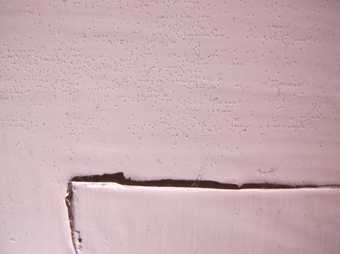
Fig.25
Gary Hume
Incubus, detail photographed in raking light in January 2019, showing a growth of fatty acid crystals that was not present in 2015
Photo © Tate
Interestingly, since July 2015 Incubus has developed large crystals similar to those removed from Water Painting (fig.25). It is three decades since Incubus was painted and it may not be a surprise that the formation of the crystals coincided with a period of display after six years of storage. It is possible that environmental changes such as a small increase in relative humidity or enhanced humidity fluctuations have prompted a shift in the chemical equilibrium within the paint – which clearly requires further research. Upon inspection, the softer sheen of this surface noted above may prove to be partially due to the gradual build-up of an efflorescence layer, as well as the different type of paint used by Hume when working in the US. The method used to clean Water Painting is a starting point when considering the treatment of Incubus. However, as every painting is unique, the different paint formulations and support structure used for Incubus may well necessitate modifications.
Taking all of this into consideration, Hume’s paintings, like many contemporary works, fall within the familiar and long-standing conservation principles that apply to historical paintings.86 Our decision to shift the focus away from preserving all of the components of the original material and instead towards recovering a more acceptable appearance is in accordance with the artist’s wishes, leading to the removal of the fatty acid exudate material. This should not be taken for granted. Artist Frank Bowling deliberately mixed soap powder with oil paint in order to produce ‘grey veils’ (caused by migrating surfactant) on the surface of his paintings (see, for example, Early Pour 1975, private collection). He also embraced effects caused by colour change in pigments, the yellowing of resinous materials and the distortion of canvas.87 In Hume’s case, the treatment is not contentious given the artist’s practice and opinions, although it is important to contextualise this within his general views on ageing, and within our current understanding of oil-containing paint behaviour.
While Hume is clear that he wishes to retain the surface gloss of his paintings, he is more ambivalent about other potential changes resulting from ageing. As he says, ‘Age comes to us, things aren’t stuck in aspic and there ought to be change. How attractive that change is, as an autonomous being … that’s up for grabs … I can live with it as long as it looks good.’88 When considering paintings by artist Piet Mondrian (1872–1944) which have ‘aged in such a beautiful way’, Hume states:
[T]hey’ve got to have a bit of ageing but like damage – it’s just such a ‘suck it and see’, because we’re at the beginning of them hitting a certain age, when they start to show themselves. It’s an ongoing, interesting question … but I have chosen to paint in these paints that haven’t got a history of their own ageing process yet, I can’t be sure about it.89
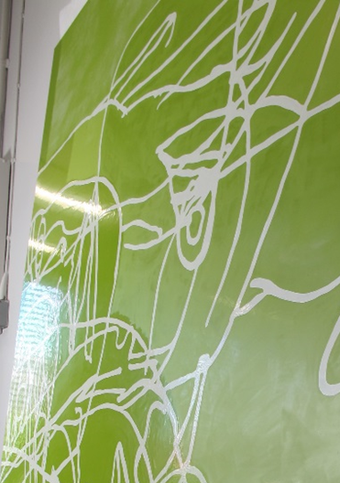
Fig.26
Gary Hume
Water Painting photographed in the studio during cleaning, showing the play of light necessary to experience the painting’s glossy effect
Photo © Tate
Hume is very conscious of the difficulty of accurately recording the appearance of his paintings using photography. This difficulty also has implications for conservators, for whom documentation plays a vital role, particularly when change is anticipated and for those charged with the care of his works without the advantages afforded by consultation with the artist. In the same way that our own perception shifts, we must question how accessible or accurate digital reproductions are and how documentation methods fare in accurately recording our perception of such aspects as colour, scale and tactility. More specifically, we must consider how best to capture the subtleties of the continuous and ephemeral movement of light across paint surfaces. This is shown in an image taken during the cleaning of Water Painting, where the contrast between the cleaned areas and those yet to be treated is clear (fig.26).
Hume is aware of other potential chemical changes to his paint films, such as the yellowing of the oil component or the slow fading of pigments, as the pigments in household paints are potentially more likely to fade than those in artists’ paints: ‘Every colour will change at a different rate to the other colour. Most of my paintings have between two and four colours, so it might be interesting. I know that in the universe nothing is fixed. I paint things in the universe, so I accept it and I accept it positively, but I’m intrigued by it.’90 He recalls looking at a painting by Sidney Nolan, who worked in oil-modified alkyd house paints from the 1940s onwards (for instance in the aforementioned painting Camel and Figure), stating that it ‘gave me encouragement, because it looked really great. But then I thought, I’ve no idea what that is. What he really used and what I’m really using because it’s all chemistry.’91 The inorganic pigments and most of the organic pigments found during the analysis of Hume’s paintings at Tate are relatively lightfast, meaning that they are not particularly prone to discolouring when exposed to light.92 However, the presence of toluidine red in Red Barn Door, a pigment which is not regarded as lightfast enough for artist-quality paints, means that this painting could be classed as moderately light sensitive.93
Conclusions
Hume remains strongly committed to household gloss paint as his chosen medium and is fully engaged in exploring its technical possibilities. His continuous honing of his methods has a subtle but important impact on the surfaces of his paintings, as technical analysis shows. Hume says ‘I still use it with very small incremental moments of revelation: “a line! foam!”, but no, I’m not using it to its potential, but I’m using the little bit that I use to its potential.’94 His more recent work is another evolution from these panel paintings: he applies gloss paint onto large sheets of primed paper that undulate and cockle as the paint dries, forming lively and sculptural reflective surfaces, as seen in works such as Three Leaves 2016–17 (Matthew Marks Gallery, New York) and Water 2018 (Sprueth Magers Gallery, London).
With respect to caring for Hume’s paintings, our course of action is clear for the foreseeable future: we have the artist’s sanction regarding treatments that aim to maintain the high gloss surfaces that he achieved via the careful development of his materials and methods. How close we can get to their original appearance remains subjective, based on Hume’s memory and his opinion of a satisfactory level of gloss. However, with the attrition of patina imparted by the cleaning, the results of these treatments will inevitably become less satisfactory over time. Our judgement of how far the gloss is reduced from its original level will be ever more subjective, and photography is of limited use due to the difficulty of documenting these subtle surfaces adequately. Gloss measurements may prove useful for comparison, but these instruments are not as sensitive as the human eye and rely on access and consistent instrumentation for optimal results.

Fig.27
Gary Hume in front of Water Painting at Tate Store, London in 2015
Photo © Tate
Most importantly, conversations with Hume himself have been critical to our decision making (fig.27), and in applying our conservation principles, all parties recognise that there is no knowing or predicting what values will be considered important in the future. We are also aware that our treatment choices naturally reflect our knowledge of paints and their ageing profiles as well as current attitudes to aesthetics, ageing and change in works of art, even subconsciously. Hume’s own pragmatic view of instinctive judgements of the appearance of the work will no doubt continue to prove a useful guide; as he says, ‘I can live with it as long as it looks good’.95
